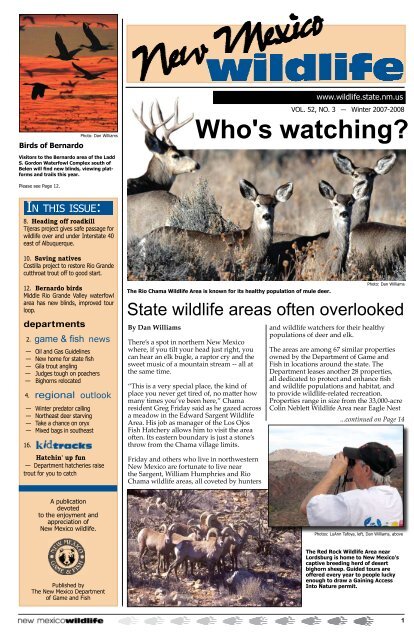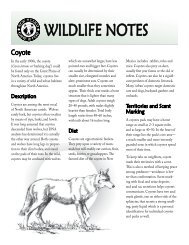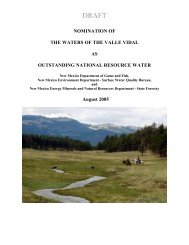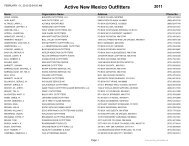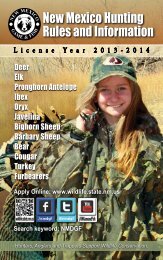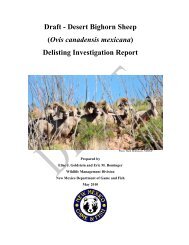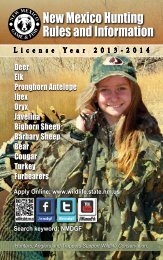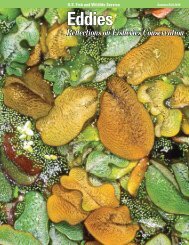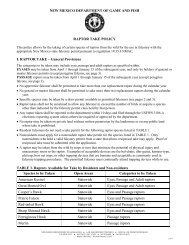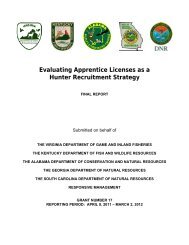Create successful ePaper yourself
Turn your PDF publications into a flip-book with our unique Google optimized e-Paper software.
www.wildlife.state.nm.usVOL. 52, NO. 3 — Winter 2007-2008Birds of BernardoPhoto: Dan Williams<strong>Who's</strong> <strong>watching</strong>?Visitors to the Bernardo area of the LaddS. Gordon Waterfowl Complex south ofBelen will find new blinds, viewing platforms<strong>and</strong> trails this year.Please see Page 12.In t h i s i ss u e:8. Heading off roadkillTijeras project gives safe passage forwildlife over <strong>and</strong> under Interstate 40east of Albuquerque.10. Saving nativesCostilla project to restore Rio Gr<strong>and</strong>ecutthroat trout off to good start.12. Bernardo birdsMiddle Rio Gr<strong>and</strong>e Valley waterfowlarea has new blinds, improved tourloop.departments2.— Oil <strong>and</strong> Gas Guidelines— <strong>New</strong> home for state fish— Gila trout angling— Judges tough on poachers— Bighorns relocated4.— Winter predator calling— Northeast deer starving— Take a chance on oryx— Mixed bags in southeast16.game & fish newsregional outlookHatchin' up fun— Department hatcheries raisetrout for you to catchThe Rio Chama Wildlife Area is known for its healthy population of mule deer.State wildlife areas often overlookedBy Dan WilliamsThere’s a spot in northern <strong>New</strong> <strong>Mexico</strong>where, if you tilt your head just right, youcan hear an elk bugle, a raptor cry <strong>and</strong> thesweet music of a mountain stream -- all atthe same time.“This is a very special place, the kind ofplace you never get tired of, no matter howmany times you’ve been here,” Chamaresident Greg Friday said as he gazed acrossa meadow in the Edward Sargent WildlifeArea. His job as manager of the Los Ojos<strong>Fish</strong> Hatchery allows him to visit the areaoften. Its eastern boundary is just a stone’sthrow from the Chama village limits.Friday <strong>and</strong> others who live in northwestern<strong>New</strong> <strong>Mexico</strong> are fortunate to live nearthe Sargent, William Humphries <strong>and</strong> RioChama wildlife areas, all coveted by hunters<strong>and</strong> wildlife watchers for their healthypopulations of deer <strong>and</strong> elk.Photo: Dan WilliamsThe areas are among 67 similar propertiesowned by the Department of <strong>Game</strong> <strong>and</strong><strong>Fish</strong> in locations around the state. TheDepartment leases another 28 properties,all dedicated to protect <strong>and</strong> enhance fish<strong>and</strong> wildlife populations <strong>and</strong> habitat, <strong>and</strong>to provide wildlife-related recreation.Properties range in size from the 33,000-acreColin Neblett Wildlife Area near Eagle Nest...continued on Page 14A publicationdevotedto the enjoyment <strong>and</strong>appreciation of<strong>New</strong> <strong>Mexico</strong> wildlife.Photos: LuAnn Tafoya, left, Dan Williams, abovePublished byThe <strong>New</strong> <strong>Mexico</strong> Departmentof <strong>Game</strong> <strong>and</strong> <strong>Fish</strong>The Red Rock Wildlife Area nearLordsburg is home to <strong>New</strong> <strong>Mexico</strong>'scaptive breeding herd of desertbighorn sheep. Guided tours areoffered every year to people luckyenough to draw a Gaining AccessInto Nature permit.1
game&fish newsOil <strong>and</strong> Gas Guidelines publication addressesdevelopment's effects on <strong>New</strong> <strong>Mexico</strong> wildlifeIn its ongoing efforts to enhance <strong>and</strong>protect <strong>New</strong> <strong>Mexico</strong>’s wildlife <strong>and</strong>habitat, the <strong>New</strong> <strong>Mexico</strong> Departmentof <strong>Game</strong> <strong>and</strong> <strong>Fish</strong> has publisheda set of guidelines for oil <strong>and</strong> gasdevelopers, regulatory agencies <strong>and</strong>concerned citizens to promote attentionto conservation while continuing todevelop energy resources.“These guidelines were developedat my request to further conserveour precious wildlife <strong>and</strong> supportinghabitat,” Governor Bill Richardsonsaid.The Oil <strong>and</strong> Gas DevelopmentGuidelines publication is available onthe Department’s website,State fish getsa special homeabove Santa FeMcClure Reservoir, a major storagesite for Santa Fe’s water supply <strong>and</strong>forbidden fruit for anglers, is now anursery for <strong>New</strong> <strong>Mexico</strong>’s state fish, theRio Gr<strong>and</strong>e cutthroat trout.The Department of <strong>Game</strong> <strong>and</strong> <strong>Fish</strong>stocked about 2,000 6- to 12-inch troutin the reservoir Dec. 6. The fish will beused as brood stock to produce more ofthe native trout to be stocked in watersaround the state.McClure Reservoir is one of twoimpoundments on the headwatersof the Santa Fe River that are usedfor the city’s water storage. Together,they are capable of supplying 40percent of Santa Fe’s freshwater needs.Public access to McClure, <strong>and</strong> NicholsReservoir downstream is restrictedto official use to protect the city’swatershed.“This is an ideal location to exp<strong>and</strong> ourefforts to produce more Rio Gr<strong>and</strong>ecutthroats for our restoration program<strong>and</strong> for recreation,” said Kirk Patten,Department fisheries biologist. “Italso will give us an opportunity toreplace non-native fish in the SantaFe watershed with natives -- our statefish.”Each of the stocked cutthroats isinjected with a passive integratedtransponder tag, similar to the tinycomputer chips used to identifypets. The tags will allow biologiststo identify the pure-strain nativefish when they are captured laterfor spawning. In the spring <strong>and</strong>early summer, fish will be collectedby electroshocking, nets <strong>and</strong> othermethods. Eggs will be stripped fromthe females <strong>and</strong> fertilized by milt from<strong>New</strong> <strong>Mexico</strong> anglers now have moreopportunities to catch -- <strong>and</strong> even keep-- a Gila trout, because of the recentdownlisting of the species from thefederal endangered list <strong>and</strong> subsequentactions by the State <strong>Game</strong> Commission.The <strong>Game</strong> Commission removed theprohibition on possession of Gila troutat its November meeting, an action thatwill allow the Department of <strong>Game</strong><strong>and</strong> <strong>Fish</strong> to stock 2,000 to 3,000 of therare fish in public waters other thanthose designated as recovery streams.Before the federal downlisting, thewww.wildlife.state.nm.us. It contains39 pages of discussion, research,<strong>and</strong> suggested options to furtherresponsible energy developmentwhile maintaining responsibleenvironmental practices. Written <strong>and</strong>researched by Department biologistRachel Jankowitz, the publicationaddresses the inherent problemsenergy development poses to wildlife,such as habitat fragmentation <strong>and</strong>degradation, erosion, water quality,<strong>and</strong> chemical hazards. It alsoincludes recommendations to avoidproblems <strong>and</strong> mitigate existing habitatdegradation.The guidelines address oil <strong>and</strong> gasdevelopment effects on sensitivespecies <strong>and</strong> the state’s species ofgreatest conservation need, asidentified in the ComprehensiveWildlife Conservation Strategy for<strong>New</strong> <strong>Mexico</strong>. It also recognizes theimportance of wildlife to <strong>New</strong> <strong>Mexico</strong>’seconomy <strong>and</strong> quality of life. Wildliferelatedrecreation brings an estimated$1 billion a year to the state.The guidelines are intended toprovide information <strong>and</strong> promotediscretionary use among industries,regulatory agencies <strong>and</strong> citizens whorecognize the negative impacts oil <strong>and</strong>gas development can have on wildlife<strong>and</strong> habitat -- <strong>and</strong> who are open tosuggestions about ways to remedyproblems.Photo: Dan WilliamsBobby Chavez helped stock about 2,000 genetically pure Rio Gr<strong>and</strong>ecutthroat trout in McClure Reservoir on the headwaters of the Santa FeRiver in December. The fish will be used to help exp<strong>and</strong> <strong>and</strong> preservepopulations of <strong>New</strong> <strong>Mexico</strong>'s state fish.the males, <strong>and</strong> then the fish will bereturned to the water. The eggs willbe transported to the Seven SpringsHatchery, where they will be hatched<strong>and</strong> raised to stockable-sized fish.Under an agreement with the Cityof Santa Fe, the Department hopesto stock 100 to 500 adult Rio Gr<strong>and</strong>ecutthroat trout in the reservoir eachyear.Department could not stock those“extra” Gila trout raised every yearin the Mora National <strong>Fish</strong> Hatchery,because doing so would also eliminateangling in those waters. Stockings ofGila trout ranging from 2 inches tomore that 12 inches most likely willoccur in southern <strong>New</strong> <strong>Mexico</strong> lakes<strong>and</strong> streams this year.A related action by the <strong>Game</strong>Commission placed a daily bag limitof two Gila trout <strong>and</strong> unlimited browntrout, with no gear restrictions, inGilita, Willow <strong>and</strong> Little Turkey creeks<strong>New</strong> <strong>Mexico</strong>’s population of RioGr<strong>and</strong>e cutthroat trout currently islimited to 84 small headwater streamsin the northern part of the state. TheDepartment’s ongoing restorationproject intends to exp<strong>and</strong> thatpopulation, preserve the pure nativestrains of the fish, <strong>and</strong> keep the speciesoff state <strong>and</strong> federal endangered listswhile maintaining cutthroat anglingopportunities.Commission exp<strong>and</strong>s Gila trout opportunitiesabove the confluence of Gilita Creek<strong>and</strong> Snow Creek.The objective of both actions was toprovide angling opportunities <strong>and</strong>exp<strong>and</strong> habitat for pure strains ofGila trout, which currently occupy11 streams in <strong>New</strong> <strong>Mexico</strong> <strong>and</strong> twostreams in Arizona.Limited catch-<strong>and</strong>-release angling forGila trout also will be available onselect streams this year. Details willbe available soon on the Department'swebsite, www.wildlife.state.nm.us.<strong>New</strong> <strong>Mexico</strong> Departmento f Ga m e a n d <strong>Fish</strong>Bruce ThompsonDirectorRobert JenksDeputy DirectorLuke ShelbyAssistant Director for ResourcesPatrick BlockAssistant Directorfor Support ServicesMike Sloane<strong>Fish</strong>eriesR. J. KirkpatrickWildlife ManagementMatt WunderConservation ServicesDan BrooksLaw EnforcementMartin FrentzelPublic Information <strong>and</strong> OutreachCarlos ValdezAdministrative ServicesShirley BakerHuman ResourcesRobert McGeeInformation ServicesAr e a Su p e r v i s o r sLuis Rios / Las CrucesLief Ahlm / RatonRoy Hayes / RoswellBrian Gleadle / AlbuquerqueState Ga m e Co m m i s s i o nAlfredo Montoya, ChairmanAlcaldeTom Arvas, Vice-ChairmanAlbuquerqueLeo SimsHobbsS<strong>and</strong>y BuffettSanta FeM. H. “Dutch” SalmonSilver CityJim McClinticAlbuquerqueTerry RileyTijerasProviding <strong>New</strong> <strong>Mexico</strong><strong>and</strong> its wildlifeYear-roundExcellentServices<strong>New</strong> <strong>Mexico</strong> Wildlife is published by the PublicInformation <strong>and</strong> Outreach Division, N.M.Department of <strong>Game</strong> <strong>and</strong> <strong>Fish</strong>.Contact <strong>New</strong> <strong>Mexico</strong> Wildlife for permissionto reprint content.Printed in the United States under contractwith the State of <strong>New</strong> <strong>Mexico</strong>.Volume 52, Number 3Dan J. WilliamsEditorLance CherryChief of PublicationsLetters may be sent to:<strong>New</strong> <strong>Mexico</strong> WildlifeP.O. Box 25112Santa Fe, NM 87504-5112Telephone (505) 476-8004dan.williams@state.nm.usvisit our website:http://www.wildlife.state.nm.us2Volume 52, Number 2
Judges get toughon illegal outfitters,wildlife poachersBy Dan WilliamsGRANTS – An outfitter who admittedto cheating hunters, forging licenses<strong>and</strong> evading state taxes was sentencedto 10 years in jail in one of <strong>New</strong><strong>Mexico</strong>’s biggest cases of poaching <strong>and</strong>wildlife-related fraud, <strong>and</strong> one of theharshest sentences ever h<strong>and</strong>ed downin <strong>New</strong> <strong>Mexico</strong> for wildlife-relatedcrimes.The September sentencing was thefourth in the past 18 months in which<strong>New</strong> <strong>Mexico</strong> wildlife crimes resultedin significant jail time.Thirteenth Judicial District CourtJudge Camille Olguin also sentencedAdrian Romero, 35, to five yearsprobation following his jail term, <strong>and</strong>ordered him to pay almost $200,000 inrestitution to 28 hunters whom he <strong>and</strong>his wife, Henrietta Romero, swindledin their illegal hunting <strong>and</strong> outfittingoperation from 2002 to 2004. TheRomeros pleaded guilty in October2006 to a combined 10 felony charges,including racketeering, forgery, taxevasion <strong>and</strong> embezzlement. HenriettaRomero, 33, was sentenced Oct. 30 tofive years probation as part of a pleaagreement.“It is important that we prosecutethese types of cases vigorously – tosend a strong message that <strong>New</strong><strong>Mexico</strong> will not tolerate this type ofillegal activity,” District AttorneyLemuel Martinez said. “We place highvalues on our trophy wildlife, <strong>and</strong> wemust protect it along with the integrityof legitimate hunters <strong>and</strong> guides.”The Romeros, of Grants, were indictedin January 2006 on 66 felony chargesrelated to the operation of theirbusiness, Non-Typical Outfitters.They were accused of forging huntinglicenses <strong>and</strong> hunters’ signatures,arranging <strong>and</strong> conducting illegalhunts, <strong>and</strong> failing to report state grossreceipts amounting to $244,000, onwhich substantial state taxes wereevaded. Their plea agreements requirethem to pay thous<strong>and</strong>s of dollars inrestitution to all fraud victims listedin the indictments, <strong>and</strong> to reimbursethe state for all back taxes. HenriettaRomero also agreed to never againact as a hunting guide, outfitter orl<strong>and</strong>owner agent, <strong>and</strong> to give up herhunting <strong>and</strong> fishing privileges for 15years in <strong>New</strong> <strong>Mexico</strong> <strong>and</strong> the other23 states that are members of theInterstate Wildlife Violator Compact.The indictments were the resultof a 1 ½-year investigation by theDepartment of <strong>Game</strong> <strong>and</strong> <strong>Fish</strong> <strong>and</strong> the<strong>New</strong> <strong>Mexico</strong> Taxation <strong>and</strong> RevenueDepartment.“Illegal hunting is becoming more of acommercial, high-dollar activity – <strong>and</strong>those activities are often accompaniedby tax evasion,” said Alvan Romero,director of the Taxation <strong>and</strong> RevenueDepartment’s Tax Fraud InvestigationsDivision. “I see our division becomingmore <strong>and</strong> more involved in these typesof investigations.”“These cases are well-worth the wait<strong>and</strong> all the hard work,” said ChrisChadwick, a Department conservationofficer who was in the thick of theRomero investigation. “We’re hopingthis will send a message to out-of-statehunters that it is safe to hunt herein <strong>New</strong> <strong>Mexico</strong>, <strong>and</strong> that we won’ttolerate unethical or illegal outfitters.”Recent cases that resulted in jail timefor the convicted included:• October 2006: A former CatronCounty outfitter was sentencedto serve nine years in jail inconnection with an illegal huntingoperation. Rita Floyd, 54, pleadedguilty to racketeering, fraud over$2,500, <strong>and</strong> two misdemeanorcounts of outfitting without alicense. She originally was chargedwith 101 counts, including 60felonies, for her role in an illegalscheme to forge licenses <strong>and</strong> sellhunts to out-of-state hunters.• February 2007: A Guadalupita mancaught trespassing <strong>and</strong> hunting elkwithout a license was sentenced to30 days in jail <strong>and</strong> ordered to pay$2,114 in fines.• July 2007: A jury convicted a Taosman of poaching elk -- his fifthwildlife-law conviction -- <strong>and</strong> ajudge sentenced him to six monthsin jail <strong>and</strong> ordered him to pay$4,208 in fines. Three other menconvicted in connection with thepoaching of four cow elk werefined more then $1,000 each <strong>and</strong>put on probation.• August 2007: Two Fort Worth menwere sentenced to 90 days in jail<strong>and</strong> ordered to pay $10,750 each incriminal <strong>and</strong> civil penalties afterthe men went on an antelopekillingspree along the highwaybetween Raton <strong>and</strong> Clayton. Themen killed five antelope <strong>and</strong> werein possession of a deer they killedillegally in Idaho.Alfredo Montoya, Chairman of the<strong>New</strong> <strong>Mexico</strong> <strong>Game</strong> Commission,said harsh sentences <strong>and</strong> significantcivil penalties are needed to deterpeople seeking to profit by stealing<strong>New</strong> <strong>Mexico</strong>’s wildlife. The stateLegislature, Gov. Bill Richardson <strong>and</strong>the Commission have approved civilpenalties up to $10,000 for poachersconvicted of taking “trophy” wildlife.“Maybe jail time <strong>and</strong> heavy fines willget the message across to people whoare essentially stealing some of ourmost prized resources,” Montoya said.“Our trophy wildlife means a lot toour legitimate hunters <strong>and</strong> outfitters,<strong>and</strong> it has a significant impact on ourrural economies. These recent courtcases illustrate the Department’scommitment to stop the poaching <strong>and</strong>protect our resources.”Recent studies indicate that hunting<strong>and</strong> other wildlife-associatedrecreation bring nearly $1 billion to<strong>New</strong> <strong>Mexico</strong>’s economy, including $127million from outfitting <strong>and</strong> guidingbusinesses.The <strong>New</strong> <strong>Mexico</strong> Department of <strong>Game</strong><strong>and</strong> <strong>Fish</strong> encourages citizens to jointhe anti-poaching fight by using theDepartment’s toll-free Operation <strong>Game</strong>Thief hotline, (800) 432-GAME (4263),or visiting the Department's website,www.wildlife.state.nm.us. Reporterscan remain anonymous <strong>and</strong> receiverewards if charges are filed. To reporttax fraud, please call the <strong>New</strong> <strong>Mexico</strong>Tax Fraud Hotline, (866) 457-6789.Photo: Kathleen RaphaelA bighorn ewe jumps out of the trailer <strong>and</strong> sprints into its new homein the Rio Gr<strong>and</strong>e Gorge, where it will join an existing herd released in2006 by Taos Pueblo.Bighorns have new homesin Gorge, Dry Cimarron<strong>New</strong> <strong>Mexico</strong> has larger Rocky Mountainbighorn sheep herds in the northeast<strong>and</strong> in the Rio Gr<strong>and</strong>e Gorge followingthe release of 59 sheep captured Aug.10-11 in the Pecos Wilderness.A crew of <strong>New</strong> <strong>Mexico</strong> Department of<strong>Game</strong> <strong>and</strong> <strong>Fish</strong> biologists, conservationofficers <strong>and</strong> staff used drop nets baitedwith salt blocks to capture the sheepnear Pecos Baldy. The sheep were thentransported by helicopter to Terrero,where they received blood tests,vaccinations <strong>and</strong> were fitted with radiocollars.Thirty-four sheep were taken to the DryCimarron River Canyon in northeastern<strong>New</strong> <strong>Mexico</strong>, where they willsupplement an existing small southernColorado herd that occasionally usesthe Dry Cimarron area.Twenty-five sheep were taken to Bureauof L<strong>and</strong> Management property in theRio Gr<strong>and</strong>e Gorge, where they will joina small herd released last year by TaosPueblo.“The sheep released last year areadapting quite well to the Rio Gr<strong>and</strong>eGorge,” said Elise Goldstein, a bighornsheep biologist for the Department. “Infact, the new herd produced about 12lambs this spring.”The <strong>New</strong> <strong>Mexico</strong> National Guardprovided a Blackhawk helicopter <strong>and</strong>crew to move trapping gear into thewilderness <strong>and</strong> back. RepresentativesGila monsterMitch Ballard's second choice in thedraw for a 2007 elk license will be hisfirst from now on. A monster 7-by-7bull settled that. It's a trophy by anyst<strong>and</strong>ards. Now it's only a matter ofwaiting for the official scoring: Will ittop 370? Ballard took the big bull withone shot through the heart from about200 yards on the third day of the firstrifle hunt in Unit 16 B, an area knownfor its large elk. He <strong>and</strong> three friendswere self-guided, <strong>and</strong> carried the elk outin quarters on backpacks. "It happenedreal fast, <strong>and</strong> it's a good thing because Iwould have fallen to pieces if I had hadto look at him for very long," Ballardsaid. "Up to then, the only elk I've seenthat big were either on the wrong side ofthe fence or on someone else's wall."from Taos Pueblo, the BLM <strong>and</strong> theU.S. Forest Service also assisted in thetrapping <strong>and</strong> release operation.Bighorn sheep restoration beganin <strong>New</strong> <strong>Mexico</strong> in the 1930s, butstruggled until the animals weremoved to the Pecos Wilderness in the1960s. That herd is now the source formany transplant operations, <strong>and</strong> thestatewide population now has grownto approximately 1,000 sheep. Movingthe animals helps keep the populationwithin the limits of the available alpinehabitat.The Rio Gr<strong>and</strong>e Gorge near the TaosJunction Bridge was identified assuitable low-elevation habitat forbighorn sheep in 1993.“We’re thrilled to be a partner in thiseffort,” said Linda Rundell, <strong>New</strong><strong>Mexico</strong> State Director of the BLM.“As part of our agency’s Restore <strong>New</strong><strong>Mexico</strong> program, we’re working withl<strong>and</strong>owners, conservation groups <strong>and</strong>other agencies to restore degradedl<strong>and</strong>scapes <strong>and</strong> habitats throughout<strong>New</strong> <strong>Mexico</strong>. The final step –reintroducing native wildlife to areaswhere they’ve declined or disappeared– is the icing on the cake.”Funding for the traps <strong>and</strong> transplantingoperations comes from the Foundationfor North American Wild Sheep <strong>and</strong> thefederal aid program of the U.S. <strong>Fish</strong> <strong>and</strong>Wildlife Service.Photo courtesy of Mitch Ballard3
egional outlookNorthwestPhoto: Dan WilliamsWinter is prime time for predator callingCunning coyoteschallenge hunters,wildlife watchersBy Ross MorganHow many times have you beensitting with your back against a treecalling turkeys, <strong>and</strong> just as a bigTom struts in to your decoy -- justwhen you are getting ready to shoot-- he suddenly spooks <strong>and</strong> runs off?You sit there for a second trying tofigure out what went wrong, <strong>and</strong>then you suddenly catch movementout of the corner of your eye. As youturn <strong>and</strong> look, you see a bobcat or acoyote creeping through the brush,headed in the direction of the fleeingturkey.It turned out that while you werecalling a turkey, you also werecalling the turkey’s predators – asporting activity in itself.Predator calling is one of the fastestgrowinghunting sports in NorthAmerica. It isn’t hard to learn; allyou need is some persistence <strong>and</strong> alittle patience. If you aren’t a hunterbut enjoy viewing wildlife, a setof camouflage clothing, a goodpredator call <strong>and</strong> a little bit of timecan produce some really goodphotos or video.Calls <strong>and</strong> camoCalls are designed to make noisesresembling those made by awounded animal, usually thepredators’ prey species. Threetypes of calls can be used: openreed,closed-reed <strong>and</strong> electronic.All can be highly effective <strong>and</strong>cost anywhere from $5 to $600,depending on whether they arecustom, commercial, h<strong>and</strong>made orelectronic. The best way to learnhow to call is to spend a day withan experienced caller learning thebasics on how to call <strong>and</strong> the bestplaces to make st<strong>and</strong>s. If you don’tknow anyone who has experiencepredator calling, there are manytypes of instructional “how to”videos <strong>and</strong> tapes available on-lineor at your local sporting goods storethat can help you out almost as well.Predator calling isn’t muchdifferent than other types ofhunting when it comes to clothing.It is very important to concealyourself by choosing <strong>and</strong> wearingcamouflage that best matches yoursurroundings. Most predators areknown for their sharp eyesight, keenhearing <strong>and</strong> keen sense of smell, soyou want to make sure that you arevery well concealed <strong>and</strong> that youalways call into the wind. However,sometimes the bobcats or coyotestravel around you <strong>and</strong> come indownwind if they are suspicious.This is why you always want tokeep your eyes open <strong>and</strong> pay closeattention.Photo: Jennifer MorganPredator calling can be rewarding whether you're after a pricey peltor a prize photograph. Above, the author poses with a coyote hecalled in during a trip to northern <strong>New</strong> <strong>Mexico</strong>.Typically, the best times to call arethe first couple hours after sunrise<strong>and</strong> the last couple hours beforedark. Choosing the right kind ofcall, <strong>and</strong> finding the right spot toset up <strong>and</strong> make a st<strong>and</strong> are equallyimportant. Depending on theterrain, a st<strong>and</strong> can last anywherefrom 15 to 45 minutes. The rule ofthumb is that the more open theterrain, the longer the st<strong>and</strong>. I had aprofessor in college once tell me thatif you called in one coyote for everyfour st<strong>and</strong>s that you made, youwere doing really well. Don’t be in ahurry to leave. You don’t want to bewalking back to the truck, <strong>and</strong> thenturn around <strong>and</strong> see a coyote of foxrunning off.The top choices of firearms amongmost predator callers are .17, .22,.23, .24 or .25 caliber rifles, with themost popular cartridges being .17,.22-250, .223 <strong>and</strong> .25-06. In someareas with thick brush, a 12-gaugeshotgun with No. 4 buckshot may bea better choice. These calibers are themost popular because of their abilityto kill the animal <strong>and</strong> not ruin thehides. You want to be sure <strong>and</strong> notruin these hides because some ofthem can be worth a pretty goodchunk of change, especially bobcats.Plenty of spaceSome private l<strong>and</strong>owners havemanagement plans that includethe taking of predators <strong>and</strong> oftentimes are willing to let hunters ontheir property to call <strong>and</strong> take them.Always remember to ask first beforehunting or fishing on private l<strong>and</strong>s.However, there is a vast amount ofpublic l<strong>and</strong> that is accessible within<strong>New</strong> <strong>Mexico</strong> for calling predators<strong>and</strong> doesn’t require a lot of timesearching.This year, the State <strong>Game</strong>Commission acquired an easementthat allows hunters, anglers <strong>and</strong>trappers to harvest protectedspecies on certain State Trust l<strong>and</strong>s.Unprotected species also may betaken on easement l<strong>and</strong>s by personsholding valid hunting or trappinglicenses for protected species onthose l<strong>and</strong>s in season.Licenses <strong>and</strong> rulesOne thing to remember if you decideto head out <strong>and</strong> give predatorcalling a try is that coyotes <strong>and</strong>skunks are not protected furbearers.Resident hunters don't need alicense, Habitat Stamp or a HabitatManagement <strong>and</strong> Access Validation.Nonresidents are required to have avalid hunting license of any type tohunt nongame species.Raccoons, badgers, weasels, foxes,ringtail cats, bobcats, muskrats,beavers <strong>and</strong> nutria are protected <strong>and</strong>do require a <strong>New</strong> <strong>Mexico</strong> trapperslicense.To learn more about dates <strong>and</strong>license fees, see the furbearerportion of the <strong>New</strong> <strong>Mexico</strong> Big<strong>Game</strong> <strong>and</strong> Trapper Rules <strong>and</strong>Information Booklet. When in doubt,contact your local Department of<strong>Game</strong> <strong>and</strong> <strong>Fish</strong> conservation officeror area office.Photo: Dan WilliamsRoss Morgan is the Department of<strong>Game</strong> <strong>and</strong> <strong>Fish</strong> public informationofficer for the northwest area. He can bereached at area office in Albuquerque at(505) 222-4704 or ross.morgan@state.nm.us.4Volume 52, Number 2
Northeast deer are starving,according to recent studyNortheastDrought, poor habitat linked to population declines across the WestBy Clint HensonFor years, a favorite questionaround coffee shops <strong>and</strong> campfireshas been, “Where are all the deer?”Then there’s the recollection,“When I was a kid, there were deereverywhere.”Conversations begin to get reallyinteresting when people startspeculating about what happenedto the deer. Coyotes, lions, overhunting,not enough hunting, toomany elk – the accusations go on<strong>and</strong> on. It seems the only point ofagreement is that deer populationsare down, <strong>and</strong> not just in <strong>New</strong><strong>Mexico</strong>. Most of the West is alsowondering, “Where are the deer?”An ambitious study was beguna few years ago in northeast<strong>New</strong> <strong>Mexico</strong> to try to answerthat question. The Santa Fe TrailAdaptive Management Partnership(STAMP) researched deer survivalon more than 1.2 million acres ofpublic <strong>and</strong> private l<strong>and</strong>s in ColfaxCounty. Researchers includedrepresentatives from the <strong>New</strong><strong>Mexico</strong> Cooperative WildlifeResearch Unit from <strong>New</strong> <strong>Mexico</strong>State University, the BerrymanInstitute from Utah StateUniversity, <strong>and</strong> the <strong>New</strong> <strong>Mexico</strong>Department of <strong>Game</strong> <strong>and</strong> <strong>Fish</strong>.“This was one of the first majorresearch <strong>and</strong> managementefforts in the region, if notnationally, where public <strong>and</strong>private interests workedcollaboratively to investigate<strong>and</strong> address declining mule deerpopulations,” said Barry Hale,deer biologist for the <strong>New</strong> <strong>Mexico</strong>Department of <strong>Game</strong> <strong>and</strong> <strong>Fish</strong>.The study began in December 2001by capturing <strong>and</strong> radio-collaring38 mule deer does. Researchersobserved the does for three years<strong>and</strong> evaluated their survival <strong>and</strong>the survival of their fawns. Theyalso tracked the deer’s movements<strong>and</strong> studied the habitats theyused. Many other factors wereevaluated, including precipitation,hiding cover, <strong>and</strong> current <strong>and</strong> pastl<strong>and</strong> management practices.Each doe was assessed fornutritional health using ultrasoundto measure body fat levels. Theinitial data were surprising: Thebody fat of the captured deerranged from only 6 to 9 percent.This was extremely low <strong>and</strong>showed that the available nutritionwas very deficient in the summer<strong>and</strong> fall of 2001.Researchers waited <strong>and</strong> watchedeach deer once a week as theyapproached fawning season. Asthe fawns were born, they wouldbe found hiding in dense cover<strong>and</strong> were easy to catch so theycould be weighed <strong>and</strong> radiocollared.Again, the first data werenot good. The average birth weightPhotos: Clint HensonA study in northeastern <strong>New</strong> <strong>Mexico</strong> indicated that malnutrition wasthe leading cause of deer deaths, <strong>and</strong> that a deer fawn is 20 timesmore likely to survive for ervery 1 percent increase in body fat of themother doe.of 19 fawns born in 2002 was only2.3 kilograms (5.07 pounds). Thebirth weight should be more than3.6 kilograms (7.94 pounds). All ofthe fawns died within 26 days ofbirth in the first year of study. Butthe worst was not over for 2002.The survival rate for the does wasthe lowest recorded for any deerpopulation -- 63 percent. Thirteenof the 38 collared deer died in2002, along with all of the fawns.As researchers found each carcass,the cause of death was classifiedas malnutrition, predation,illegal harvest, accidental,disease or unknown. If the bodycondition was very poor, thedeer was classified as dying frommalnutrition, even if it had beenscavenged by predators. So it cameas no surprise that malnutritionwas the most common cause ofdeath in 2002. Extremely lowprecipitation levels in ColfaxCounty in 2001 <strong>and</strong> the spring of2002 were not enough to producethe food needed for the deer tothrive. The drought led to lowbody fat in does, low birth weightsof the fawns, <strong>and</strong> a downwardpopulation trend of 36 percent.Research from the first year of theSTAMP project, while dismal, gavebiologists the first real answerto the deer population decline:starvation. Fortunately, the deerhad better luck in the next twoyears. Rainfall levels returned tomore normal patterns in the spring<strong>and</strong> summer of 2003 <strong>and</strong> wereabove average in 2004.In 2003 <strong>and</strong> 2004, 69 more doeswere captured, radio-collared <strong>and</strong>studied for survival. Another 21deer were captured <strong>and</strong> checkedfor body condition, but werenot radio-collard. Malnutritioncontinued to be the main causeof deer mortality throughoutthe study period, even thoughconditions improved into 2004.As precipitation increased so did,body fat levels in does, <strong>and</strong> fawnbirth weights. Survival numbersincreased slightly in 2003 as 3 of 34fawns survived through December.In 2004, 28 of 47 fawns survived,with a total doe survival rate of 91percent. The overall populationgain, however, was only 6 percent.In 2002 the population decline was36 percent, <strong>and</strong> in 2003 it was a 5percent decline.Researchers calculated that afawn was 3.4 times more likelyto survive for every 1 kilogramgain in birth weight, 8.8 timesmore likely to survive forevery 1 centimeter of summerprecipitation, <strong>and</strong> 20 times morelikely to survive for every 1percent increase in the body fatof the mother doe. Another factorthat aided in fawn survival wasthe increase in hiding cover in 2003<strong>and</strong> 2004.The study also found that asbirth weights increased, the birthdates were earlier. Most fawnswere born around July 14 in 2002,July 8 in 2003 <strong>and</strong> July 3 in 2004,indicating that does will holdfawns longer to increase birthweights. Earlier birth dates forfawns showed that the mother hadbetter nutrition, which meant more<strong>and</strong> better quality milk for thefawns. This helped the fawns growfaster with a much better survivalrate.When researchers compared deerbody conditions with habitatuse, they found that body fat wasproportional to the pinon-junipercommunities in the annual <strong>and</strong>summer home ranges. The higherthe amounts of pinon-juniper ina deer’s home range, the lower itsbody fat percentage. And becausebody fat in does is the singlebestpredictor of fawn survival,addressing this type of habitatmay be a key to increasing highquality habitat for deer.The easy part of the STAMPresearch is over. Now begins thechallenge to l<strong>and</strong> managers toimprove habitat <strong>and</strong> availableforage, which will take many years<strong>and</strong> some help from the weather.Ultimately, <strong>New</strong> <strong>Mexico</strong> lives ordies by the rains, <strong>and</strong> when itcomes to measuring the effectsof precipitation on habitat <strong>and</strong>wildlife, deer are <strong>New</strong> <strong>Mexico</strong>’scanaries in the mine shaft.Clint Henson is the Department of<strong>Game</strong> <strong>and</strong> <strong>Fish</strong> public informationofficer for the Northeast Area. He canbe reached at the Raton office, (505)445-2311 or clint.henson@state.nm.us.Photo: Dan Williams<strong>New</strong> <strong>Mexico</strong>'s large areas of pinon-juniper is not ideal habitat for muledeer, according to a recent study of deer survival in northeastern <strong>New</strong><strong>Mexico</strong>.5
Don't miss your shotat an oryx this yearBy LuAnn TafoyaGot oryx? <strong>New</strong> <strong>Mexico</strong> has moreof the African antelope thanit needs, <strong>and</strong> invites everyoneseeking an impressive trophy orwho is just fond of tasty gamemeat to take a crack at the annualdrawing for licenses.Applications for hunts must beeither postmarked or submittedonline by midnight Feb. 6. Hunterscan find all the details in the2008-2009 Big-<strong>Game</strong> Hunting &Trapping Rules & Informationbooklet, available. The bookletswill be available in December onthe Department of <strong>Game</strong> <strong>and</strong> <strong>Fish</strong>website, www.wildlife.state.nm.us,<strong>and</strong> at vendors statewide <strong>and</strong>Department offices in Santa Fe,Albuquerque, Las Cruces, Raton<strong>and</strong> Roswell.Various types of oryx hunts areoffered on White S<strong>and</strong>s MissileRange <strong>and</strong> on public <strong>and</strong> privatel<strong>and</strong>s off-range. If you are lookingto hunt all month long, tryapplying for one of the off-rangepopulation-management hunts.Open areas include l<strong>and</strong> controlledby the U.S. Forest Service, Bureauof L<strong>and</strong> Management, the Stateof <strong>New</strong> <strong>Mexico</strong>, <strong>and</strong> privateproperty with written permission.A good l<strong>and</strong>-status map is highlyrecommended if you draw apopulation-management license.If you’re hunting just for someexcellent oryx meat, try applyingfor one of the “as called”population-management hunts.You may be assigned to hunt onWhite S<strong>and</strong>s Missile Range, SanAndres National Wildlife Refugeor on l<strong>and</strong>s controlled by otheragencies that require a $150 accessfee. Up to 250 hunters may receivelicenses, based on a rankingsystem. Keep in mind that 155hunters were called during the2006-2007 hunting season, <strong>and</strong> thehigher your ranking number, theless likely you will get called. Ifyou are lucky enough to be called,it may be on short notice, so beprepared. Individuals can onlyapply for one type of populationmanagementhunt.If you’re looking for a trophy, tryapplying in for a weekend oncein-a-lifetimehunt on White S<strong>and</strong>sMissile Range. There are threedifferent locations on the rangethat are included in these hunts:Rhodes Canyon, Small MissileRange, <strong>and</strong> Stallion Range. Allareas offer good hunting, butkeep in mind that there are fewerlicenses issued for the SmallMissile Range, so your odds ofdrawing one may be longer. Youwill be required to pay the $150access fee <strong>and</strong> you will not be ableto apply for one of these huntsagain once you’ve drawn one.The odds of drawing a once-ina-lifetimeoryx license are about6.4-to-1. Last year, 10,179 huntersapplied for 1,585 licenses.Another option is to apply for abroken-horn hunt. These hunts areavailable to those who have notheld a once-in-a-lifetime hunt. Thebag limit for these hunts is an oryxof either sex that has one or morehorns missing at least 25 percent ofits normal growth.If you have never gone oryxhunting <strong>and</strong> are successful inthe drawing, expect a great time.Oryx are smart creatures, <strong>and</strong>over the years these hunts havebecome more difficult. Glassing<strong>and</strong> stalking are the most effectivehunting techniques. If you spooka herd or oryx, move on <strong>and</strong> findanother group to stalk. If you justdrive around the range all day,expect to come up empty h<strong>and</strong>ed.Get away from the roads <strong>and</strong>you’ll find oryx.Once you have successfullyharvested your oryx, get ready forwork. Oryx have very tough hides<strong>and</strong> you’ll go through severalknives if you don’t have the righttype. In the end, oryx meat will notdisappoint you. The meat is lean,with a rich but mild flavor. Trymarinating oryx steaks in olive oilbefore grilling them, then enjoy!LuAnn Tafoya is the Department of<strong>Game</strong> <strong>and</strong> <strong>Fish</strong> public informationofficer for the Southwest Area. She canbe reached in area office in Las Crucesat (505) 532-2106 or luann.tafoya@state.nm.us.GAIN puts participants up-close-<strong>and</strong>-personal with wildlifeBy LuAnn TafoyaApplication deadline is Feb. 6If you’re looking for a non-huntingactivity that will put you in touchwith wildlife, check out GainingAccess into Nature (GAIN). Theprogram has become increasinglypopular since the <strong>New</strong> <strong>Mexico</strong>Department of <strong>Game</strong> <strong>and</strong> <strong>Fish</strong>started it two years ago. Activitiesinclude guided tours to see elk,deer, lesser prairie chickens, <strong>and</strong>bighorn sheep. Occasionally,participants can assist Departmentbiologists <strong>and</strong> conservation officersSouthwestin electroshocking fish surveys,bighorn sheep trapping operations<strong>and</strong> other projects.Participants are chosen by alottery-type online drawing, <strong>and</strong>successful applicants are chargednominal fees. To see current GAINopportunities <strong>and</strong> applicationdeadlines, please visit www.wildlife.state.nm.us, <strong>and</strong> click onthe “Recreation” tab at the top ofthe page.GAIN activities in the southwestarea include visits to the RedRock Wildlife Management Area,home of the endangered desertbighorn sheep. Visitors to the area24 miles north of Lordsburg getto see the site of the Department’scaptive breeding program,where sheep are raised, thentrapped <strong>and</strong> released in bighornhabitat elsewhere in the state.GAIN participants are escortedthrough the expansive sheeppens, where they have excellentphoto opportunities <strong>and</strong> views ofthe sheep. Lucky applicants alsolearn about the desert bighornmanagement plan <strong>and</strong> objectives,funding for the program, predatorcontrol, <strong>and</strong> sheep biology. Somelucky GAIN applicants get to tagalong, shoot photos <strong>and</strong> evenpitch in <strong>and</strong> help biologists as theycatch, treat, transport <strong>and</strong> releasethe sheep into new habitats.Perhaps the most popular of theGAIN activities in the southwestalso is the newest. This past fall,12 lucky participants accompaniedDepartment’s wolf biologist <strong>and</strong>regional outlookPhoto: Don MacCarterHunters who apply for a once-in-a-lifetime hunt for oryx in <strong>New</strong><strong>Mexico</strong> have about a 1-in-6 chance of getting a license in the annualdrawing.tracked Mexican wolves in theGila National Forest. Individualslearned what a day in the life of awolf biologist was like <strong>and</strong> detailsabout the wolf reintroductionprogram. The tour was a full dayof driving forest roads <strong>and</strong> usingelectronic monitoring equipmentto “track” wolves.More GAIN activities are expectedto be offered in 2008, so stay tunedto the Department website fordetails.Desert bighornsheep are raisedat the RedRock WildlifeManagementArea <strong>and</strong> thencaptured <strong>and</strong>relocatedin suitablehabitat suchas the HatchetMountains ofsouthern <strong>New</strong><strong>Mexico</strong>.Photo: Dan Williams6Volume 52, Number 2
Head southeast for a mixed bag of birdsHunt for waterfowlin the morning,quail after noonBy Mark MadsenEarly morning ... sun’s coming up… clear sky … looks like it’s goingto be a beautiful, mild winter day.Decoys are set … very little wind… <strong>and</strong> the birds are starting to fly.Sounds like the start of a goodmorning of waterfowl hunting.The location could be in the upperMidwest or the flooded timber ofthe Mississippi Delta. But whatabout <strong>New</strong> <strong>Mexico</strong>?When you mention <strong>New</strong> <strong>Mexico</strong>,most hunters think about monsterRocky Mountain elk or trophymule deer. People don’t normallyassociate <strong>New</strong> <strong>Mexico</strong> withgood hunting opportunities forwaterfowl. That said, severallocations in <strong>New</strong> <strong>Mexico</strong> offerexcellent waterfowl hunting. Oneof those areas is the Pecos RiverValley from Roswell to Carlsbad,where hunters can find lots ofducks, geese <strong>and</strong> s<strong>and</strong>hill cranes.Eastern <strong>New</strong> <strong>Mexico</strong> is part ofthe Central Flyway <strong>and</strong> containsnumerous locations where ducks,geese <strong>and</strong> cranes stop on theirsouthern migration. Some flockseven hang around all winter.Places like Bitter Lakes NationalWildlife Refuge, the OverflowWetl<strong>and</strong>s, <strong>and</strong> the Seven RiversWaterfowl Management Areaoffer food <strong>and</strong> security tomigrating waterfowl.Open Gate, a new l<strong>and</strong>ownerincentiveprogram offered by theDepartment of <strong>Game</strong> <strong>and</strong> <strong>Fish</strong>,also opens a couple of privateproperties for waterfowl hunting.Both of these areas are along thePecos River east of Roswell.Waterfowl outlook goodThis season, hunters can expectto find many species of ducks,with mallards being especiallyplentiful. Good opportunities alsoexist for pintails <strong>and</strong> canvasbacks.The valley attracts good numbersof snow geese, some CanadaPhoto: Lance CherryWaterfowl hunting is expected to be good to excellent this seasonin southeastern <strong>New</strong> <strong>Mexico</strong>.geese <strong>and</strong> s<strong>and</strong>hill cranes that callthe valley home for the wintermonths. Duck season opened inlate October <strong>and</strong> runs throughJan. 27. Pintail <strong>and</strong> canvasbackseason opens Dec. 20. The seasonfor light <strong>and</strong> dark geese openedin mid-October <strong>and</strong> runs throughJan. 27. S<strong>and</strong>hill crane seasonopened Oct. 31 <strong>and</strong> runs throughthe end of January.The majority of the waterfowl<strong>and</strong> cranes in the Pecos Valleyroost on Bitter Lakes NationalWildlife Refuge <strong>and</strong> then scatterthroughout the valley duringthe early morning hours to feed.Smaller numbers of ducks, geese<strong>and</strong> cranes roost on the OverflowWetl<strong>and</strong>s.Hunters have good success inthe public hunt area along thesouthern boundary of the middletract of the refuge as well as theprivate property just north of U.S.380. One of the new Open Gateproperties is north of U.S. 380along the Pecos River <strong>and</strong> shouldoffer hunters some good passshootingopportunities.Duck hunters also might try theOverflow Wetl<strong>and</strong>s just westof Bottomless Lakes State Park.Another Open Gate property isjust south of the state park <strong>and</strong>borders the Overflow Wetl<strong>and</strong>s.The Seven Rivers WildlifeManagement Area is at thenorth end of Brantley Reservoirbetween Artesia <strong>and</strong> Carlsbad.This area offers good-to-excellentlate-season hunting opportunitiesfor waterfowl <strong>and</strong> s<strong>and</strong>hill cranes.Special hunt rules are in affectfor Bitter Lakes National WildlifeRefuge <strong>and</strong> Seven Rivers WildlifeArea.Most of the better goose huntingopportunities occur on privatel<strong>and</strong>s throughout the valley whenflocks l<strong>and</strong> to feed in agriculturalfields. Some access may beobtained by hunters who takethe time to find out who ownsthe fields <strong>and</strong> then get writtenpermission to hunt from thel<strong>and</strong>owner. The same scenario istrue for s<strong>and</strong>hill crane hunting.Some geese <strong>and</strong> s<strong>and</strong>hill cranesalso can be taken when they areleaving the Bitter Lakes refugefirst thing in the morning.Afternoon quail, dovesSo, you’ve had a good morninghunting waterfowl <strong>and</strong> s<strong>and</strong>hillcranes, but you haven’t had yourfill of bird hunting for the day?Before you pack everything up<strong>and</strong> head to the house, how aboutchanging out the non-toxic shotfor some lead <strong>and</strong> hunting dove<strong>and</strong> quail?The nice thing about winterhunting in southeastern <strong>New</strong><strong>Mexico</strong> is that waterfowl seasonsare open during the same times asupl<strong>and</strong> game birds. Dove seasonis open until the end of December,<strong>and</strong> quail season runs until Feb.15. You can hunt waterfowl <strong>and</strong>cranes in the morning, switch toupl<strong>and</strong> game birds during themiddle of the day, <strong>and</strong> then beback in your favorite duck blindfor the evening hunt.last fall also kept a lot of dovesin the country. Good numbers ofmourning <strong>and</strong> white-wings canstill be found. Eurasian collareddoves also live year-round in thePecos Valley.Hunters wanting to pursuebobwhite quail should try theClovis/Portales area. Most of thebetter bobwhite hunting is onprivate property, so you must getwritten permission.Public hunting opportunitiesfor bobwhites can be found onthe Department’s lesser prairiechicken areas in the Milnes<strong>and</strong>area. Only non-toxic shot maybe used on Department-ownedwildlife areas.Lots of public l<strong>and</strong>Good scaled quail hunting can befound throughout southeastern<strong>New</strong> <strong>Mexico</strong>. Scaled quail occupymany habitat types <strong>and</strong> it comesdown to the type of terrain youprefer to hunt. Scaled quail canbe found in the s<strong>and</strong> county thatstarts east of Roswell <strong>and</strong> runsall the way to the Texas stateline southeast of Carlsbad. Theyalso can be found throughoutthe Pecos River Valley <strong>and</strong> thefoothills of the lower Sacramento<strong>and</strong> Guadalupe Mountains.Thous<strong>and</strong>s of acres of publicl<strong>and</strong>s (BLM, state, <strong>and</strong> NationalForest) can be found throughoutsoutheastern <strong>New</strong> <strong>Mexico</strong>,providing more than adequateaccess for upl<strong>and</strong> game birdhunting. Several Open Gateproperties also have been openedup, providing additional huntingopportunities on private l<strong>and</strong>.For more information about birdhunting opportunities on theBitter Lakes National WildlifeRefuge, call Steve Alvarez at(505) 625-4009. For informationabout Seven Rivers WaterfowlManagement Area, call RichardArtrip at (505) 457-2660. Moreinformation about the OpenGate program can be found onthe Department of <strong>Game</strong> <strong>and</strong><strong>Fish</strong> website, www.wildlife.state.nm.us, or by calling GeorgeFarmer at (505) 624-6135.Mark Madsen is the Department of<strong>Game</strong> <strong>and</strong> <strong>Fish</strong> public informationofficer for the southeastern area ofthe state. He can be reached in theRoswell area office at (505) 624-6135or mark.madsen@state.nm.us.Photo: Dan WilliamsPlenty of spring <strong>and</strong> summer moistsure brought good quail habitatfor quail in southeastern <strong>New</strong> <strong>Mexico</strong>. Scaled quail are the mostcommon species, although hunters also can find bobwhite <strong>and</strong>Gambel's quail.Better-than-average precipitationduring the spring <strong>and</strong> summerhas resulted in excellent dove<strong>and</strong> quail habitat. Some arearanchers have reported seeingseveral hatches of quail thisyear, especially scaled quail.Bird numbers should be good,with coveys scattered just abouteverywhere. The mild weatherSoutheast7
Roadkill takes a detourTijeras Canyonproject createssafe passageBy Dan WilliamsWith a lot of help from their friends, deer<strong>and</strong> other wildlife now can commute moresafely between habitats in the S<strong>and</strong>ia <strong>and</strong>Manzano mountains east of Albuquerque.Activation of electric fencing <strong>and</strong> highwaymats now provides the animals safe passageover <strong>and</strong> below Interstate 40 <strong>and</strong> N.M. 333,formerly Route 66.Laura Finley, a volunteer member ofthe Albuquerque-based Wild Friendsconservation group, flipped the switch tothe system designed to keep wildlife -- <strong>and</strong>vehicles -- out of harm’s way.“This was a really neat project from thebeginning,” said Finley, one of 800 studentswho participate in the Wild Friends effortseach year. “We didn’t have trouble gettingpeople interested in it because we all haveseen road kill while driving around thestate. It was amazing how it grew <strong>and</strong> howmuch community support there was.”The ambitious project has roots in the 2003Legislature <strong>and</strong> House Joint Memorial 3,sponsored by Rep. Mimi Stewart, withsupport from Wild Friends. The memorialdirected the Department of <strong>Game</strong> <strong>and</strong> <strong>Fish</strong><strong>and</strong> the Department of Transportation towork together to reduce wildlife-vehiclecollisions in <strong>New</strong> <strong>Mexico</strong>. Before long, thecommunity was on board <strong>and</strong> the TijerasCanyon Safe Passage Coalition was formed,consisting of federal <strong>and</strong> state agencyemployees, UNM employees, Carnuel L<strong>and</strong>Grant members, conservation groups <strong>and</strong>Mark Watson, a habitatspecialist with theDepartment of <strong>Game</strong> <strong>and</strong><strong>Fish</strong>, looks for wildlifetracks in in an Interstate40 overpass in TijerasCanyon. Members ofthe Tijeras CanyonSafe Passage Coalitioncleared away nonnativevegetation underoverpasses so animalswill have safe routesto sources of food <strong>and</strong>water on both sides of thefreeway.8Photo: Dan Williamsconcerned citizens.Turning on the power was among the finalsteps in the development of a $750,000system to reduce wildlife-vehicle collisionsalong five miles of highways through TijerasCanyon, where about 30 deer, bears <strong>and</strong> anoccasional mountain lion die every year. Theelectrical system is a vital component of theproject, which also includes 8-foot wildlifeprooffencing, passages under existingoverpasses, warning signs <strong>and</strong> solarpoweredmotion-detecting cameras that turnon highway caution lights.“This is the only system of its kind in<strong>New</strong> <strong>Mexico</strong> <strong>and</strong> among only a few in thePhotos: Mark Watson, Dan WilliamsMore than 700 wild animals arekilled every year on <strong>New</strong> <strong>Mexico</strong>'shighways (top).A $750,000 network of fencing,warning lights <strong>and</strong> under-freewaypassages is designed to preventabout 30 collisions between vehicles<strong>and</strong> large game animals ayear in Tijeras Canyon (above).United States,” said Mark Watson, a habitatspecialist with the Department of <strong>Game</strong><strong>and</strong> <strong>Fish</strong>. “We’re expecting it to significantlyreduce vehicle-wildlife collisions in TijerasCanyon. It also will reconnect S<strong>and</strong>ia <strong>and</strong>Manzano mountain wildlife habitats, givinganimals safer passage to seasonal sourcesof food, water <strong>and</strong> shelter.” Nationwide, anestimated 71 million acres of wildlife habitatare lost to primary highways. The InsuranceInstitute for Highway Safety estimates thatmore than 1.5 million deer-vehicle collisionsa year result in more than 29,000 humaninjuries, 150 deaths <strong>and</strong> $1.1 billion inproperty damage.The 7-foot-high Electrobraid fencing inTijeras Canyon is designed to deliver a mildshock to animals that touch it, discouragingthem from passing through. The fencesconsist of several horizontal str<strong>and</strong>s of blackrope-like material that is about a half-inchin diameter. The fence can deliver a 6,000- to7,000-volt, 4 milliamp shock for 3/10,000 th ofa second -- enough to sting, but not seriouslyharm a human. The Electrobraid FenceCompany in <strong>New</strong> Brunswick, Canada, willmonitor the fence 24 hours a day by satellite,alerting local crews if repairs are needed.The project also includes five Electromats,which are built into roadways <strong>and</strong>act like electric cattle guards, preventingwildlife or other animals from crossing.The approximately 4-foot-wide mats spanVolume 52, Number 2
Dangerousvehicle-wildlifecollision highways1. Tijeras Canyon (deer) – Interstate 40/N.M.333, Bernalillo County.2. San Augustine Pass (deer/bighorn sheep)-- U.S. 70, Dona Ana County.3. Raton Pass (deer, cougar, bear, elk) –Interstate 25, Colfax County.4. Burro Mountains (deer, elk, javelina) – N.M.90, Grant Co. -- Tyrone5. Cloudcroft to Mayhill (deer, elk) – U.S. 82<strong>and</strong> N.MM. 130, Otero County.6. Ruidoso/Capitan/Hondo Valley area(deer, elk, bears) – U.S. 70, U.S. 380, N.M. 48,N.M. 37, Lincoln County.7. Cimarron area (deer, elk, bear) – U.S. 64through Cimarron Canyon, Colfax Co.8. Gila National Forest (elk, deer, javelina,bears) – Silver City area, U.S. 180 from N.M. 78to N.M. 12, Grant <strong>and</strong> Catron Counties.9. Rio Arriba/San Juan counties (deer, elk)– U.S. 64/84 from Tierra Amarilla to Bloomfield,<strong>and</strong> to the Colorado border.10. Glorieta to Las Vegas (bear, deer, elk) –Interstate 25, Santa Fe <strong>and</strong> San Miguel counties.the roadways in four locations along N.M.333 <strong>and</strong> across the I-40 on- <strong>and</strong> off-rampsat Tijeras. The mats along N.M. 333 aredesigned to encourage wildlife to cross theroad in designated areas where motiondetectingcameras trigger caution lightsthat alert motorists to slow down whenwildlife are present. Pedestrians can safelywalk across the mats as long as they arewearing shoes, <strong>and</strong> bicyclists can cross withno problem. Timed switches will allow dogs<strong>and</strong> horses to cross. The on- <strong>and</strong> off-rampmats are designed to keep wildlife off thefreeway. Twelve specially designed escaperamps were constructed in case animalssomehow become trapped inside the I-40fencing.The additions to the wildlife corridorwere included in the $27 million GRIP1-40 Carnuel-to-Tijeras project. GovernorRichardson’s Investment Partnership,or GRIP, is a $1.6 billion transportationinitiative aimed at improving the state’shighways, while creating thous<strong>and</strong>s of localjobs.“This has been an exciting <strong>and</strong> educationalproject for us,” said Mark Fahey, a projectdesign engineer for the Department ofTransportation. “We did some things we’venever done before, <strong>and</strong> I learned a lot aboutthe status of Tijeras Canyon as a back-<strong>and</strong>forthroute for wildlife.”Councilor Martin Heinrich <strong>and</strong> the CityCouncil <strong>and</strong> get the property just in time,”said Scott Wilber, director of the <strong>New</strong><strong>Mexico</strong> L<strong>and</strong> Conservancy, which facilitatedthe deal. “Before that, HawkWatch wasconsidering selling the property to anybuyers, <strong>and</strong> they were getting lots of offersfrom developers.”Watson said the Tijeras project is a stepin ongoing efforts to reduce the 700 to900 collisions between large wildlife <strong>and</strong>vehicles that are reported in the state everyyear, <strong>and</strong> many others that are not reported.A fencing project on U.S. 550 between Aztec<strong>and</strong> the Colorado border, <strong>and</strong> the Tijerasproject already have helped reduce thosenumbers, paving the way for similar projectsin the future.“Now that everything is in place, the longtermsuccess of the Tijeras Canyon SafePassage Project will require monitoringby the Department of <strong>Game</strong> <strong>and</strong> <strong>Fish</strong> <strong>and</strong>the Department of Transportation <strong>and</strong> anan expectation by the public that all thecomponents are maintained <strong>and</strong> functional,”Watson said. He is monitoring wildlifereactions to the fencing <strong>and</strong> how underhighwaypassages are utilized to determinehow well the system is working.“We hope to demonstrate that wildlifevehiclecollisions in Tijeras Canyon aregreatly reduced <strong>and</strong> that this system willprovide safe passage for wildlife in theS<strong>and</strong>ias <strong>and</strong> Manzanos into perpetuity,”Watson said.One key component of the project wassecured when the City of Albuquerquepurchased 63 acres of l<strong>and</strong> north of I-40 fromHawkWatch International. The $650,000purchase protected a vital wildlife corridorfrom impending housing developments. Theproperty is now designated as “open space.”“We were able to work with former CityPhoto: Dan WilliamsElectric highway mats, electric fencing <strong>and</strong> chain-link fencing work together to keep wildlife outof harm's way on N.M. 333, formerly Route 66, in Tijeras Canyon.9
Saving the nativesCostilla project willprotect pure-straincutthroat troutBy Dan WilliamsTy Mitchel gently lifted the small trout <strong>and</strong>held it in the sunlight to see its brilliantcolors -- orange <strong>and</strong> gold, with distinct blackspots toward its tail.“Beautiful, just beautiful,” he said, returningthe fish to the upper Rio Costilla in northern<strong>New</strong> <strong>Mexico</strong>. “How often do you get achance to catch a native cutthroat?”<strong>New</strong> <strong>Mexico</strong> anglers are fortunate to haveopportunities to catch Rio Gr<strong>and</strong>e cutthroattrout. The state fish inhabits about 84streams in the northern part of the state,<strong>and</strong> although its habitat has dwindled to 11percent of what it once was, the trout is notconsidered endangered or threatened.Kirk Patten, a fisheries biologist with theDepartment of <strong>Game</strong> <strong>and</strong> <strong>Fish</strong>, hopes tokeep it that way. This past summer, Patten<strong>and</strong> fellow biologist Eric Frey led a teamon a mission to preserve pure strains ofthe native fish for posterity. A few milesupstream from Mitchel, they were applyingthe pesticide rotenone to Comanche Creek<strong>and</strong> its tributaries in the Valle Vidal Unit ofthe Carson National Forest.“The treatment was the last phase in astepwise approach to eliminate all the nonnativefish species from the drainage,”Patten said. “Once we’ve done that, we canreturn the pure-strain Rio Gr<strong>and</strong>e cutthroatsto their historic habitat.” If all goes well,he said pure-strain cutthroat trout couldbe restocked in Comanche Creek <strong>and</strong> itstributaries sometime next year."We consider this project extremelyimportant, not only because it's our statefish, but also because it's the Department'sm<strong>and</strong>ate to protect native species," Pattensaid. "The Rio Gr<strong>and</strong>e cutthroat troutis found only in one place in the world-- southern Colorado <strong>and</strong> northern <strong>New</strong><strong>Mexico</strong>. It would be tragic <strong>and</strong> irresponsiblefor us to see a native species permanentlydisplaced by non-natives."Photos: Dan WilliamsCostilla Creek in the Valle VidalUnit of the Carson National Forestis known for its spectacularscenery <strong>and</strong> outst<strong>and</strong>ing anglingopportunities for Rio Gr<strong>and</strong>ecutthroat trout. Keeping a pure strainof the trout -- <strong>New</strong> <strong>Mexico</strong>'s statefish -- is the objective of a 10- to15-year project that started in June2007.In July, about 20 miles of streamswere treated in the first phase of theambitious project to restore native cutthroatsto the Rio Costilla watershed, which consistsof more than 150 miles of streams, 25 smalllakes <strong>and</strong> Costilla Reservoir. Project partnersinclude the Department of <strong>Game</strong> <strong>and</strong> <strong>Fish</strong>,U.S. <strong>Fish</strong> <strong>and</strong> Wildlife Service, U.S. ForestService, Interstate Stream Commission,Trout Unlimited, <strong>New</strong> <strong>Mexico</strong> Trout, TurnerEnterprises <strong>and</strong> the Vermejo Park Ranch,the Rio Costilla Cooperative LivestockAssociation, <strong>and</strong> others. Patten said heexpects the entire project to take 10 to 15years.“It is definitely a long-term commitment,”Patten said. “This summer was a great firststep.”Before the treatment, trout <strong>and</strong> other nativespecies were removed or relocated byelectroshocking, netting <strong>and</strong> by relaxingfishing regulations. Rotenone, an organicpesticide derived from plant roots, helpedeliminate the remaining fish.“We were able to save most of the troutbefore we treated the stream,” Patten said.“We salvaged around 2,000 trout <strong>and</strong> movedthem downstream to the Rio Costilla forangling.” He said the rotenone took care ofalmost all of the remaining fish, includingrainbow trout, "cutbows," which areRio Gr<strong>and</strong>e cutthroat trout (Oncorhynchus clarki viriginalis)Historic range: Most likely encompassedall cool waters in the Rio Gr<strong>and</strong>e drainage,including the Chama, Jemez <strong>and</strong> Rio San Joseriver drainages, along with suitable waters ofthe Pecos <strong>and</strong> Canadian river drainages.Habitat requirements: Clear, cold water,naturally-fluctuating flows, low levels of finesediment in channel bottoms, well-distributedpools, stable stream banks, <strong>and</strong> abundantstream cover.Threats: Habitat loss, caused mainly bylivestock grazing, water diversions, logging,road building <strong>and</strong> urban <strong>and</strong> agriculturaldevelopment, <strong>and</strong> introduction of exotic fishesare the primary causes of decline. Becauseof the small size <strong>and</strong> isolation of Rio Gr<strong>and</strong>ecutthroat streams, most remnant populationsare also vulnerable to environmentalperturbations, such as drought, fire, or freezingtemperatures, <strong>and</strong> problems associatedwith small population size, such as loss ofgenetic diversity <strong>and</strong> r<strong>and</strong>om fluctuations inpopulation size.Current population status: Pure populationsof the Rio Gr<strong>and</strong>e cutthroat trout havebeen reduced to 84 tiny headwater streams,occupying roughly 11 percent of thesubspecies’ historic range in <strong>New</strong> <strong>Mexico</strong>.Of interest: The Rio Gr<strong>and</strong>e cutthroat wasthe first North American trout observed byEuropeans. In 1541, Pedro de CastañedadeNajera, a member of Coronado’s expedition,described “a little stream which aboundsin excellent trout <strong>and</strong> otter.” This stream isbelieved to be Glorieta Creek, southeast ofpresent day Santa Fe, which is now a barren,ephemeral wash for most of its length.10Volume 52, Number 2
More than 20 miles of streams in the ValleVidal Unit of the Carson National Forestwere treated in July to make way forpure-strain Rio Gr<strong>and</strong>e cutthroat trout, RioGr<strong>and</strong>e suckers <strong>and</strong> Rio Gr<strong>and</strong>e chubs.rainbow-cutthroat hybrids, <strong>and</strong> about 2,500white suckers. The rainbow trout needed tobe removed from the streams because theyinterbreed with the cutthroats.This past fall, electroshocking surveysfound one small section of stream that stillcontained live trout. Patten did not rule out aneed to retreat the streams.“Weather conditions can be unpredictableduring application, which requires us tomake constant adjustments according tostream flow,” he said. “It’s not unusual tohave to go back <strong>and</strong> retreat streams.”Creating <strong>and</strong> maintaining a watershed witha pure strain of Rio Gr<strong>and</strong>e cutthroat troutwill protect the state fish <strong>and</strong> help keep thespecies off state <strong>and</strong> federal endangered lists,which will prevent watershed-use restrictionsthat go along with those listings.Keeping the fish off the lists also will allowanglers to enjoy catching them. That is abig reason the Truchas Chapter of TroutUnlimited got involved in the project.“It’s important that we preserve the genepool so we can continue to enjoy our nativefish in a number of ways,” Truchas Chaptermember Arnold Atkins said. His organizationcontributed significantly to the project byacquiring a National <strong>Fish</strong> <strong>and</strong> WildlifeFoundation grant to install a fish passagebarrier on Comanche Creek. The barrier willprevent non-native fish from going upstream.Most of the pure-strain cutthroat troutthat are restocked in the Rio Costilla willcome from the Department’s Seven SpringsHatchery in the Jemez Mountains.Cutthroat project factsStreams reclaimedMore than 20 miles of streams werecleared last summer to make way forstockings of pure-strain Rio Gr<strong>and</strong>ecutthroat trout, native Rio Gr<strong>and</strong>e suckers<strong>and</strong> native Rio Gr<strong>and</strong>e chubs sometimenext year. Streams included ComancheCreek <strong>and</strong> most of its tributaries in theValle Vidal Unit of the Carson NationalForest.Non-natives removedThe project used electroshocking, relaxedfishing regulations <strong>and</strong>, finally, pesticidetreatment to remove more than 20,000non-native fish from the Comanche Creekwatershed. Most of those fish were nonnativewhite suckers.Trout savedMore than 2,000 trout were salvaged byelectroshocking before the treatmentprocess. Most of those trout were moveddownstream to the Rio Costilla, wherethey will provide angling opportunities.What is rotenone?Rotenone is a naturally occurringsubstance derived from the roots oftropical plants in the bean familyLeguminosae. It is classified as an organicpesticide. The EPA has concluded that itsuse for fish control does not present a riskof unreasonable adverse effects to humans<strong>and</strong> the environment.How safe is the water after treatment?The hazard associated with drinkingwater containing rotenone is very smallbecause of the low concentration ofrotenone used <strong>and</strong> its rapid breakdown.A 160-pound person would have todrink more than 23,000 gallons of watertreated at 0.25 mg of rotenone per liter ofwater (highest allowable treatment ratefor fish) at one sitting to receive a lethaldose. A bird weighing ¼ pound wouldhave to consume 100 quarts of treatedwater or more than 40 pounds of fish <strong>and</strong>invertebrates within 24 hours to receivea lethal dose. This same bird wouldnormally consume 0.2 ounces of water <strong>and</strong>0.32 ounces of food daily.Gone within hoursTests conducted during <strong>and</strong> followingtreatment of the streams showed no tracesof rotenone or other inert ingredients inthe water because of its rapid degradation<strong>and</strong> neutralization procedures.11
Birds of Bernardo<strong>New</strong> blinds, decksperfect for viewingcranes, waterfowlBy Tom ChiltonJust in time for the winter migration ofwaterfowl to the Rio Gr<strong>and</strong>e Valley, viewingblinds have been built at the Ladd S. GordonWaterfowl Complex. From the blinds <strong>and</strong>elevated platforms, visitors can watch <strong>and</strong>photograph birds from dawn to dusk.The blinds are among many recentimprovements in the waterfowl complex'sBernardo Area south of Belen, just north ofU.S. 60, an easy stop off Interstate 25. Threeelevated observation decks, built severalyears ago, now have roofs <strong>and</strong> screeningthat provide shelter from the elementswithout sacrificing viewing space. A threemileauto loop <strong>and</strong> two short hiking trailsalso give visitors views of birds in fields <strong>and</strong>ponds.Photos: Dan WilliamsAbout 200 acres of corn are grown every year at the Bernardo Wildlife Area to provide foodfor as many as 12,000 s<strong>and</strong>hill cranes <strong>and</strong> 25,000 snow geese that visit the area every winter.Feeding the birds helps keep them off farmers' fields in the Rio Gr<strong>and</strong>e Valley.Thous<strong>and</strong>s of s<strong>and</strong>hill cranes <strong>and</strong> snowgeese gather daily in the area’s cultivated,dry fields. More than a dozen speciesof ducks rest <strong>and</strong> feed in flooded fields<strong>and</strong> ponds, taking to the air in the earlymornings <strong>and</strong> late evenings. Visitors oftensee hundreds, sometimes thous<strong>and</strong>s ofcranes, geese <strong>and</strong> ducks in the air as they flyfrom one field or pond to another. The besttimes for birding are from mid-November toearly February. Most years, more than 12,000s<strong>and</strong>hill cranes <strong>and</strong> 25,000 snow geese findfood <strong>and</strong> refuge at Bernardo. That’s a lot ofquacking, honking <strong>and</strong> action for bird loversof all ages.Planting for wildlifeBernardo is one of three working farmsin the Middle Rio Gr<strong>and</strong>e Valley that aremanaged by the Department of <strong>Game</strong><strong>and</strong> <strong>Fish</strong>. Of the 1,700 acres at Bernardo,about 450 acres are cultivated annuallyto provide winter feed for migratory <strong>and</strong>upl<strong>and</strong> birds. Several fields are floodedduring the fall to provide resting areas formigrating waterfowl. Because the l<strong>and</strong>scapeis a mixture of open water, fields <strong>and</strong> densewoods, it also attracts mule deer, coyotes,raccoons, pheasants, hawks, owls, quail <strong>and</strong>songbirds.Corn is the most important crop at Bernardobecause of its high nutritional value towaterfowl. About 200 acres of corn areplanted in mid-May. Although corn is anideal food for the birds, it cannot be plantedyear after year in the same field. If this weredone, the soil would be depleted of nitrogen<strong>and</strong> the corn production would decline. Toprevent this, alfalfa is planted every otheryear, because this plant, in combinationwith bacteria in the soil, replaces nitrogenabsorbed by the corn. About 400 acres ofalfalfa are planted in the middle of April.Hay from this crop is harvested four to fivetimes from the middle of May to the firstfreeze in October. Smaller acreages of milo<strong>and</strong> millet are also planted.In the fall, corn stalks are mowed downso that birds can easily get to the grain.However, some corn rows are knocked witha pole so that the stalks are leaning over. Inthis position the corn is available mostly tothe tall cranes <strong>and</strong> not to the shorter geese.S<strong>and</strong>hill cranesPhoto: Marty FrentzelCovered blinds give visitors to Bernardo Wildlife Area protection from wind <strong>and</strong> snow along withexcellent views of the cranes <strong>and</strong> migrating waterfowl that use the area.12S<strong>and</strong>hill cranes are a big winter attraction atBernardo. With a wingspan of 5 to 6 ½ feet<strong>and</strong> weights ranging from 6 to 16 pounds,these cranes are the largest flocking birdyou will see at Bernardo. Their large sizeensures that photographers will have framefillingfun. The birds mate in the spring inthe northern United States, Canada, Alaska<strong>and</strong> Siberia. The mating pairs will tilt theirheads back <strong>and</strong> call together, singing akind of duet. Throughout the year they alsoVolume 52, Number 2
dance, run, <strong>and</strong> leap high in the air. Theyuse their large wings to slow down <strong>and</strong>make parachute-like l<strong>and</strong>ings, which areenjoyable to watch <strong>and</strong> easy to photograph.The average lifespan of a s<strong>and</strong>hill crane inthe wild is 20 years.Snow geeseEach fall more than 6 million snow geesemigrate from northern Canada to marshes,bays, fields <strong>and</strong> wet grassl<strong>and</strong>s in thewestern United States. Up to 60,000 of thesebirds come to this part of <strong>New</strong> <strong>Mexico</strong> tospend about three months in the cropl<strong>and</strong>s<strong>and</strong> wetl<strong>and</strong>s along the Rio Gr<strong>and</strong>e. Theytravel up to 3,000 miles in huge, honkingflocks – a snowstorm of big, white birdswith five-foot wingspans. From a distance,snow geese appear to be all white. However,their black wingtips are easy to see whenthey fly.A feeding flock of several thous<strong>and</strong> geesemay look like chaos, but family groups<strong>and</strong> pairs stay together, moving throughthe flock as distinct units. You can seethis behavior most easily from one of theelevated platforms at Bernardo. Each groupkeeps an area around it clear of other geeseso that competition for food is reduced. Theadult male makes sure that other geese donot come too close.In early February, the geese begin theirreturn trip north, where they will gather<strong>and</strong> breed in colonies that have between1,000 <strong>and</strong> 150,000 pairs. The majority ofthe snow <strong>and</strong> Ross’s geese migrating from<strong>New</strong> <strong>Mexico</strong> breed on Bank’s Isl<strong>and</strong> <strong>and</strong> theQueen Maud Gulf region in north-centralCanada.Watchable wildlifeThe observation platforms are excellentplaces to view all kinds of wildlife,especially shy animals that are more activeat dawn <strong>and</strong> dusk. Watch along the edgeof the woods. In most ecosystems, an edgebetween two habitats is where you will seethe most wildlife. As the sun goes down,animals such as mule deer leave the woodsto graze on grain in the fields. Coyotesemerge to scout the crop furrows forrodents. Listen for the flutter of wings, thedrumming of a woodpecker or the call of acoyote.Tracks are easy to find in the mud alongthe pond edges <strong>and</strong> in the soft dirt of thebirding tour road. There are other cluesto wildlife if you look closely. Look fordroppings, feathers, bones, eggshells <strong>and</strong>little bits of fur. Bernardo’s two short hikingtrails go through deep woods where youmay see nests <strong>and</strong> other wildlife signs.Water for waterfowlMost of the water in the ditches <strong>and</strong>ponds at Bernardo comes from the RioGr<strong>and</strong>e. Near Isleta, about 30 miles northof Bernardo, water is diverted from the RioGr<strong>and</strong>e into a network of canals <strong>and</strong> ditchesthat are accessed by farmers <strong>and</strong> ranchersthroughout the Rio Gr<strong>and</strong>e Valley. Theprimary irrigation channel in this networkflows from Isleta, through Bernardo, downto Socorro, where it rejoins the Rio Gr<strong>and</strong>e.Starting in mid-September of each year,water is diverted from this channel tocreate 17 ponds at Bernardo that coverabout 700 acres. Water depths vary froma few inches to four feet. These ponds, incombination with the seed crops planted forwildlife, provide ideal wintering habitat formigrating waterfowl.Photos: Dan Williams, above, Marty Frentzel, rightPlatforms overlooking cultivated fields of corn <strong>and</strong> milo are perfect spots to watch as many as25,000 snow geese that visit the Bernardo Wildlife Area south of Belen every winter.13
State wildlife areas often overlookedPhoto: Clint HensonGet involvedMany organizations in <strong>New</strong> <strong>Mexico</strong>are dedicated to wildlife conservation,habitat improvement <strong>and</strong> wildlife-relatedrecreation. Whether you are interested inbirding, wildlife <strong>watching</strong>, hunting, fishingor trapping, chances are there is an outfityou’ll deem worth supporting. Here are afew of them:<strong>New</strong> <strong>Mexico</strong> Wildlife Federation: Foundedby Aldo Leopold in 1914, the diverseorganization is a strong lobbyist in the<strong>New</strong> <strong>Mexico</strong> Legislature, “dedicated toprotecting <strong>New</strong> <strong>Mexico</strong>’s wildlife, habitat,<strong>and</strong> outdoor way of life.” (505) 299-5404,www.nmwildlife.org.Audubon <strong>New</strong> <strong>Mexico</strong>: Devoted to theprotection, preservation, <strong>and</strong> enjoyment ofthe environment, with a particular emphasison birds. The organization has chaptersstatewide, with headquarters at the R<strong>and</strong>allDavey Audubon Center in Santa Fe. (505)983-4609, http://nm.audubon.org....Continued from Page 1to the tiny Picacho Bosque Area, now partof Mesilla Valley Bosque State Park near LasCruces. The Department carefully controlspublic access to the properties to protect thewildlife while also providing wildlife-relatedrecreation.Over the years, the Department has purchased165,947 acres outright <strong>and</strong> currently leases50,511. Most of the areas were purchased withfederal funding derived from an 11 percentexcise tax on sporting arms, ammunition,archery equipment, a 10 percent tax onh<strong>and</strong>guns, <strong>and</strong> other excise taxes on fishingequipment <strong>and</strong> motorboat fuel. The federalfunding rules require that the l<strong>and</strong>s <strong>and</strong> waterare managed to the benefit of the fish <strong>and</strong>wildlife.Historically, hunters <strong>and</strong> anglers were the oneswho paid for <strong>and</strong> used Department l<strong>and</strong>s mostoften. Today, l<strong>and</strong> managers are seeing morediverse recreational interests in the properties.“More <strong>and</strong> more, we’re getting requests <strong>and</strong>inquiries from people who want to use wildlifeareas for hiking, photography or just wildlife<strong>watching</strong>,” said Mike Gustin, a Departmentl<strong>and</strong>s specialist. “Our challenge is to find waysto open the gates to many wildlife-related useswithout straying from our primary objective ofprotecting the wildlife.”The Department’s Gaining Access Into Nature(GAIN) program is a first step to providingmore wildlife-related recreational opportunities.Participants are selected in drawings for guidedtours for deer, elk <strong>and</strong> bighorn sheep viewing,<strong>and</strong> to occasionally help biologists with fishsurveys <strong>and</strong> big-game trapping operations.Because only a few people get to participate inthe current GAIN program, the Departmentplans to exp<strong>and</strong> it soon.“People are very familiar with many of ourproperties, such as Eagle Nest Lake, FentonLake, the Ladd S. Gordon Waterfowl Complex<strong>and</strong> some of the more popular fishing <strong>and</strong>hunting destinations,” Gustin said. “Otherproperties are not as well-known, or peopledon’t know they can use them, so we rarely seevisitors.”To help the public discover these wildlife areas,the Department plans to launch an exp<strong>and</strong>edGAIN program that will allow limited publicuse on the areas as long as those uses arewildlife-related. Permits may be required formodest weekly or annual fees. Stay tuned to theDepartment website, www.wildlife.state.nm.usfor more details.Popular wildlife management areasThe <strong>New</strong> <strong>Mexico</strong> Department of <strong>Game</strong> <strong>and</strong> <strong>Fish</strong> owns 67 <strong>and</strong> leases 28 propertiesacross the state for wildlife protection, population enhancement <strong>and</strong> wildlifeassociatedrecreation. Here are some of those areas, including details about size,wildlife <strong>and</strong> access. A complete list <strong>and</strong> maps of Department-owned <strong>and</strong> leasedl<strong>and</strong>s is available on the Department website, www.wildlife.state.nm.us.Rocky Mountain Elk Foundation: A largenational organization dedicated to ensuringthe future of elk, other wildlife <strong>and</strong> theirhabitat. The organization actively supportsefforts to protect <strong>and</strong> enhance elk country,conservation education <strong>and</strong> to restore elkherds. <strong>New</strong> <strong>Mexico</strong> information: (505) 454-9390. National website: www.rmef.org.Southwest Environmental Center: “Worksto reverse the accelerating loss of speciesworldwide by protecting <strong>and</strong> restoringnative wildlife <strong>and</strong> their habitats in theSouthwestern borderl<strong>and</strong>s, throughgrassroots advocacy, public education <strong>and</strong>on-the-ground restoration projects. (505)522-5552, www.wildmesquite.org.Southwest Consolidated Sportsmen:An organization representing at least15 sporting <strong>and</strong> conservation groups ofdiverse interests. The group’s three primaryobjectives are to “disseminate wildlife <strong>and</strong>habitat information, participate in habitatmaintenance projects, <strong>and</strong> review <strong>and</strong>comment on proposals involving wildlifehabitat. (505) 526-5056.Trout Unlimited, <strong>New</strong> <strong>Mexico</strong>: Dedicatedto the restoration, protection <strong>and</strong>conservation of all coldwater fisheries, theirtributaries <strong>and</strong> watersheds <strong>and</strong> the fish thatinhabit them in the State of <strong>New</strong> <strong>Mexico</strong>.(505) 470-4878, www.newmexicotu.org.<strong>New</strong> <strong>Mexico</strong> Wild Turkey Federation:Supports scientific wildlife managementon public, private <strong>and</strong> corporate l<strong>and</strong>s aswell as wild turkey hunting as a traditionalNorth American sport. (505) 869-3837,www.nwtf.org.Northwest areaJackson Lake Wildlife AreaLocation: Straddles N.M. 170 about 5 milesnorthwest of Farmington.Purchased: 1947 for $46,793 to provide food <strong>and</strong>resting habitat for wintering waterfowl.L<strong>and</strong> <strong>and</strong> water: 840 acres, including a 60-acre lake,agricultural fields <strong>and</strong> riparian habitat along the LaPlata River.Wildlife, fish: Waterfowl, songbirds, raptors, dove,quail, pheasants, deer <strong>and</strong> other wildlife. The lakecontains trout, catfish, bluegill <strong>and</strong> bass.Activities allowed: Waterfowl <strong>and</strong> dove hunting,fishing, other recreational activities west of N.M. 170.Restrictions, closures: Property east of the N.M.170 currently is closed to the public, but plans arein the works for some wildlife-related recreationalactivities.Edward Sargent Wildlife AreaLocation: Just north of Chama.Purchased: 1975 for $2.2 million to provide excellentelk habitat <strong>and</strong> increase hunting opportunity.L<strong>and</strong> <strong>and</strong> water: 20,208 acres of prime elk <strong>and</strong> deerhabitat, including 1.5-acre Nabor Lake, <strong>and</strong> a riparianarea along the Rio Chamita <strong>and</strong> Chama River.Wildlife, fish: Elk, deer, bears, predators, raptors,songbirds <strong>and</strong> various other wildlife. The lake <strong>and</strong>streams contain cutthroat, rainbow <strong>and</strong> brown trout.Activities allowed: Hunting, fishing, hiking,horseback riding.Restrictions, closures: Limited seasonal closuresduring hunting seasons <strong>and</strong> during calving <strong>and</strong>fawning seasons for elk <strong>and</strong> deer.Rio Chama Wildlife <strong>and</strong> <strong>Fish</strong>ing AreaPhoto: Dan WilliamsThe prime habitat for deer <strong>and</strong> elk makes for spectacular scenery at the Sargent Wildlife Area.Location: Approximately 15 miles southwest ofChama between El Vado <strong>and</strong> Heron lakes, borderedby N.M. 112 on the southeast <strong>and</strong> the Rio Chama onthe northwest.Purchased: Original purchase in 1954 with additionall<strong>and</strong> purchases through 1989 for a total of $103,500to provide deer <strong>and</strong> elk habitat <strong>and</strong> increase hunting<strong>and</strong> fishing opportunities.L<strong>and</strong> <strong>and</strong> water: 13,239 acres, including access tomore than 12 miles of the Rio Chama <strong>and</strong> 4.5 milesof El Vado Reservoir shoreline. A portion of theproperty is leased to the State Parks <strong>and</strong> RecreationDivision for camping <strong>and</strong> boating facilities.Wildlife, fish: Deer, elk, many species of birds <strong>and</strong>other wildlife. Rainbow <strong>and</strong> brown trout in theriver <strong>and</strong> lake. The lake also contains some kokaneesalmon.Activities allowed: Hunting, fishing, hiking <strong>and</strong>horseback riding. Camping in designated areas <strong>and</strong>at El Vado <strong>and</strong> Heron state parks.14Volume 52, Number 2
Restrictions, closures: Limited seasonal closures.Only licensed hunters allowed during huntingseasons.William A. Humphries Wildlife AreaLocation: 10 miles west of Chama on the ContinentalDivide off U.S. 64.Purchased: Original purchase in 1966, withadditional l<strong>and</strong> acquisitions through 1980 to providehabitat for elk, deer, bear <strong>and</strong> turkeys.L<strong>and</strong> <strong>and</strong> water: Formerly the Roque Wildlife Area,it includes 10,950 acres of prime deer <strong>and</strong> elk habitat<strong>and</strong> is a key migration route for elk.Wildlife, fish: Deer, elk, black bears, turkeys <strong>and</strong>many other species of birds.Activities allowed: Hunting, hiking, horsebackriding.Restrictions, closures: Limited seasonal closures.Only licensed hunters allowed during huntingseasons.Ladd S. Gordon Waterfowl ComplexLocation: The complex consists of four wildlife areasin the Middle Rio Gr<strong>and</strong>e Valley. Belen WaterfowlArea, 2 miles south of Belen; Casa ColoradaWaterfowl Area, 7 miles south of Belen; BernardoWildlife Area, halfway between Belen <strong>and</strong> Socorro;La Joya Waterfowl Area, 7 miles south of Bernardo.Purchased: Properties were acquired in numerousl<strong>and</strong> purchases. Original purchases <strong>and</strong> totalpurchase prices were: La Joya, 1928, $8,454; Belen,1959, $104,955; Bernardo, 1971, $174,092; CasaColorada 1981, $1,582,726.L<strong>and</strong> <strong>and</strong> water: All four areas contain ponds, ditches<strong>and</strong> irrigation canals managed to provide waterfowlresting areas during the fall <strong>and</strong> winter; <strong>and</strong> irrigatedcropl<strong>and</strong> to provide food for the birds. Total acres:Belen, 255; Bernardo, 1,676; Casa Colorada, 423; LaJoya, 3,405.Wildlife, fish: Waterfowl, upl<strong>and</strong> birds; songbirds,deer, various other wildlife species.Activities allowed: Hunting, fishing, wildlife<strong>watching</strong>, hiking in designated areas <strong>and</strong> seasons.Restrictions, closures: Limited seasonal closures forsome activities during hunting seasons <strong>and</strong> to protectmigrating waterfowl.Northeast areaCharette Lakes <strong>Fish</strong>ing AreaLocation: 23 miles southwest of Springer.Purchased: Original acquisition in 1949; subsequentl<strong>and</strong> purchases through 1959 to provide fishingopportunity <strong>and</strong> resting habitat for migratorywaterfowl. Total purchase price: $70,247.L<strong>and</strong> <strong>and</strong> water: 1,900 total acres, including twolakes, one 110 acres <strong>and</strong> the other 300 acres.Wildlife, fish: Rainbow trout, yellow perch,migrating waterfowl.Activities allowed: <strong>Fish</strong>ing, camping picnicking.Restrictions, closures: Season is March 1 throughOct. 31.Clayton Lake <strong>Fish</strong>ing AreaLocation: 15 miles north of Clayton.Purchased: 1954-55 for $44,482 to provide fishingopportunities <strong>and</strong> waterfowl habitat.L<strong>and</strong> <strong>and</strong> water: 402 total acres, including a 175-acrelake.Wildlife, fish: Largemouth bass, walleye, sunfish.Waterfowl in fall <strong>and</strong> winter.Activities allowed: <strong>Fish</strong>ing, camping. <strong>Fish</strong>ing seasonis March 1 through Oct. 31. The area is leased to theState Parks Division, which provides camping <strong>and</strong>boating facilities.Restrictions, closures: <strong>Fish</strong>ing <strong>and</strong> boating is allowedonly March 1 through Oct. 31 to protect waterfowl.Colin Neblett Wildlife AreaLocation: 2 miles east of Eagle Nest.Purchased: 1949 for $374,532 to provide qualityhabitat for deer, elk, turkey <strong>and</strong> numerous otherspecies -- with no competition from livestock.L<strong>and</strong> <strong>and</strong> water: At 33,116 acres, it is the state’slargest wildlife area. It includes 8 miles of theCimarron River.Wildlife, fish: Deer, elk, turkeys, bears <strong>and</strong> numerousbirds <strong>and</strong> other wildlife species. The river containsstocked rainbow trout <strong>and</strong> stream-bred brown trout.Activities allowed: Hunting, fishing, hiking,horseback riding, wildlife viewing <strong>and</strong> camping.The State Parks Division manages developedcampgrounds in Cimarron Canyon under a contractwith the Department.Restrictions, closures: Seasonal closures in someareas during hunting seasons.Photo: Dan WilliamsWildlife areas protect elk during the winters <strong>and</strong> calving seasons when they are vulnerable.Uracca Wildlife AreaLocation: 12 miles north of Questa.Purchased: 1966 for $250,000 to provide big-gamehabitat, primarily winter feeding grounds for deer<strong>and</strong> elk without competition from livestock.L<strong>and</strong> <strong>and</strong> water: 13,304 acres.Wildlife, fish: Deer, elk, bears, turkeys, grouse <strong>and</strong>many other species of mammals <strong>and</strong> birds.Activities allowed: Hunting, hiking, horsebackriding.Restrictions, closures: Seasonal closures to protectwintering deer <strong>and</strong> elk. Limited vehicle access.Elliott Barker Wildlife AreaLocation: 15 miles northwest of Cimarron.Purchased: 1965 for $250,000 as big-game habitat.L<strong>and</strong> <strong>and</strong> water: 5,416 acres, including Ponil Creek.Wildlife, fish: Deer, elk, turkeys, bears <strong>and</strong> manyother species. The creek contains Rio Gr<strong>and</strong>ecutthroat trout.Activities allowed: Hunting, fishing, wildlifeviewing, hiking, horseback riding.Restrictions, closures: Seasonal closures duringhunting seasons, limited vehicle access.Southeast areaLesser Prairie Chicken AreasPhoto: Dan WilliamsMore than 20,000 acres are set aside to restorepopulations of lesser prairie chickens.Location: Various locations in Roosevelt, Chaves,DeBaca <strong>and</strong> Lea counties in southeastern <strong>New</strong><strong>Mexico</strong>. Most are in Roosevelt County south ofPortales.Purchased: 1939-1950 for a combined purchase priceof approximately $78,425 to restore populations ofthe lesser prairie chicken.L<strong>and</strong> <strong>and</strong> water: Approximately 20,670 acres inmore than 20 separate locations, the largest being theGallina Wells area at 4,708 acres.Wildlife, fish: Lesser prairie chickens, quail, deer,antelope, many other species.Activities allowed: Hunting of species other thanlesser prairie chickens, wildlife viewing. Areasaround Milnes<strong>and</strong> are used during the annual LesserPrairie Chicken Festival, a three-day event limitedto about 100 participants who are given tours to leksduring the spring mating season.William S. Huey Waterfowl AreaLocation: 2 miles northeast of Artesia.Purchased: 1963-67 for $70,060 to provide food <strong>and</strong>habitat for waterfowl.L<strong>and</strong> <strong>and</strong> water: 640 acres of cultivated farml<strong>and</strong>straddling the Pecos River.Wildlife, fish: Waterfowl, s<strong>and</strong>hill cranes, pheasants,quail, dove, antelope, deer, furbearers <strong>and</strong> otherspecies. The farm provides feed for snow geese,cranes, ducks <strong>and</strong> Canada geese.Activities allowed: Hunting, fishing, wildlife<strong>watching</strong>.Seven Rivers Wildlife AreaLocation: 20 miles north of Carlsbad.Purchased: Under 25-year lease from the U.S. Bureauof Reclamation since 1994.L<strong>and</strong> <strong>and</strong> water: About 1,800 acres in farming area<strong>and</strong> 48,000 acres in the Brantley Wildlife Area,including part of the old Lake McMillan <strong>and</strong> thePecos River.Wildlife, fish: Pheasants, quail, waterfowl <strong>and</strong> otherspecies.Activities allowed: Hunting, fishing, wildlife<strong>watching</strong>, hiking.Southwest areaLake Roberts <strong>Fish</strong>ing AreaLocation: 35 miles north of Silver City.Purchased: L<strong>and</strong> purchased in 1962 for $11,035. Lake<strong>and</strong> dam built in 1963 for $140,000 in memory ofAustin A. Roberts, a Department pilot who died inthe line of duty in 1960.L<strong>and</strong> <strong>and</strong> water: 79 acres, including 71-acre lake.Wildlife, fish: Rainbow trout, catfish.Activities allowed: <strong>Fish</strong>ing, camping in a U.S. ForestService campground.Restrictions, closures: Boat use restricted to oars orelectric motors.Bill Evans LakeLocation: 8 miles south of Cliff.Purchased: 1972 for $127,000 to provide fishingopportunities.L<strong>and</strong> <strong>and</strong> water: 300 acres, including a 62-acre lakewith water pumped 300 feet uphill from the GilaRiver.Wildlife, fish: Largemouth bass, crappie, bluegill,catfish <strong>and</strong> winter rainbow trout.Activities allowed: <strong>Fish</strong>ing.Restrictions, closures: No trotlines. Boat userestricted to oars or electric motors.Red Rock Wildlife AreaLocation: 26 miles north of Lordsburg.Purchased: 1960-74, total price $83,680, originally asa holding site for exotic ungulates such as oryx, ibex<strong>and</strong> Barbary sheep being evaluated for release intothe wild. It is now devoted to captive breeding ofdesert bighorn sheep.L<strong>and</strong> <strong>and</strong> water: 1,529 acres, plus 480 adjacent acresleased from the State L<strong>and</strong> Office.Wildlife, fish: Desert bighorn sheep, javelina, quail,other species.Activities allowed: Special Gaining Access IntoNature participants are allowed inside the sheeppaddocks for guided tours.Restrictions, closures: Restricted to public access toprotect the sheep <strong>and</strong> limit their contact with humansso they can be relocated to wild areas in the state.15
Hatchin' upsome fun<strong>New</strong> <strong>Mexico</strong>'s fish hatcheries raise2 million trout a year for you to catchBy Colleen WelchA fish hatchery is home to fish eggs <strong>and</strong> growingfish. Baby fish have a fun, almost human name-- alevin. They are also called sac fry. This maysound strange unless you are a fisheries biologist,an expert on fish. <strong>Fish</strong> hatcheries have specialequipment to hatch fish eggs <strong>and</strong> care for the fishuntil they are ready for release into streams <strong>and</strong>lakes. <strong>New</strong> <strong>Mexico</strong>’s hatcheries have nurseries forfish eggs <strong>and</strong> also have the ponds <strong>and</strong> racewaysto raise fry as they grow.Nurseries for fish<strong>Fish</strong> hatcheries have similarities to humannurseries in hospitals. Human babies sometimesare put in incubators if they need special help tobreathe <strong>and</strong> keep warm. <strong>Fish</strong> eggs also are keptin incubators with fresh water <strong>and</strong> oxygen. Whilehuman incubators can hold only one baby, fishegg incubators hold thous<strong>and</strong>s of eggs. The wholenursery could have as many as 1 million eggs inincubator trays. Some of the eggs do not survive,so the fish hatchery biologist needs to have lots ofeggs.16Photos: Steve HooperVisit a fish hatcheryThe Department of <strong>Game</strong> <strong>and</strong> <strong>Fish</strong> operates fivefish hatcheries in different areas of the state. All ofthem are open to the public <strong>and</strong> welcome visitors.Some have tours <strong>and</strong> pond fishing for children.Call the hatcheries for more information.• Glenwood: Stan Long, manager, (575) 539-2461.• Lisboa Springs (Pecos): Eloy Trujillo, manager(505) 757-6360.• Los Ojos: Greg Friday, manager, (575) 588-7307.• Red River: (575) 586-0222.• Seven Springs: Tony Jacobson, manager, (575)829-3740.Hatchery jars are incubators that keep the eggsrolling with fresh water <strong>and</strong> oxygen. This keepsthe eggs healthy <strong>and</strong> helps more eggs survive.Where do hatcheries get fish eggs?<strong>Fish</strong> hatcheries get eggs from brood stock,which are adult fish that are kept for spawning.Spawning is the action of the female fish releasingher eggs into the water. Eggs taken from wildfish or brood stock is a process called artificialspawning. Hatchery workers gently squeezethe eggs from female fish <strong>and</strong> the sperm or miltfrom male fish into shallow pans. The eggs arefertilized when they mix with the milt.At a hatchery, one female trout can produce about2,000 eggs before they are safely released backinto the water.Watch them growPhoto: Dan Williams<strong>Fish</strong> eggs hatch <strong>and</strong> become alevins, orcalled sac fry, in about a month <strong>and</strong> ahalf. In the first stage of development,eggs form eyes. Later, the eggs hatch <strong>and</strong>become sac fry. After the tiny fish growout of the sac fry stage <strong>and</strong> their yolksac is absorbed as nourishment, they arePhoto: Dan WilliamsMost of the rainbow trout we catch in <strong>New</strong><strong>Mexico</strong> are raised from eggs in fish hatcheries(left). Once the eggs hatch, they are fed untilthey grow big enough to stock in lakes <strong>and</strong>streams (above), where they can be caught <strong>and</strong>either released or kept to eat.called fry. Still growing, at about three incheslong, they are called fingerlings. The fingerlingsgrow very fast, <strong>and</strong> can be stocked in lakes <strong>and</strong>streams when they are nine to 10 inches long.Hatcheries feed small fish four to eight timesevery day until they are big enough to move outof the incubators <strong>and</strong> into long, narrow raceways.In the raceways, the young trout learn to feedthemselves by bumping into underwater wiresthat automatically release fish food into the water.People who work in hatcheries are always busycaring for the fish. They keep the raceways veryclean so the fish don’t get sick. Some raceways arecovered to protect the fish from predators such asbirds <strong>and</strong> raccoons that might eat them.<strong>Fish</strong> to catchEvery year, the Department of <strong>Game</strong> <strong>and</strong> <strong>Fish</strong>stocks more than 2 million catchable-sized troutin <strong>New</strong> <strong>Mexico</strong> lakes <strong>and</strong> streams. Hatcheriesuse special trucks to move the fish. Sometimeshelicopters drop fish into waters where there areno roads. Other times, small fish are put in specialcontainers <strong>and</strong> carried to back-country lakes <strong>and</strong>streams by horses <strong>and</strong> mules.Colleen Welch is co-coordinator for conservationeducation <strong>and</strong> Project Wild for the Department of<strong>Game</strong> <strong>and</strong> <strong>Fish</strong>. She can be contacted at (505) 476-8119 or colleen.welch@state.nm.us.Volume 52, Number 2


